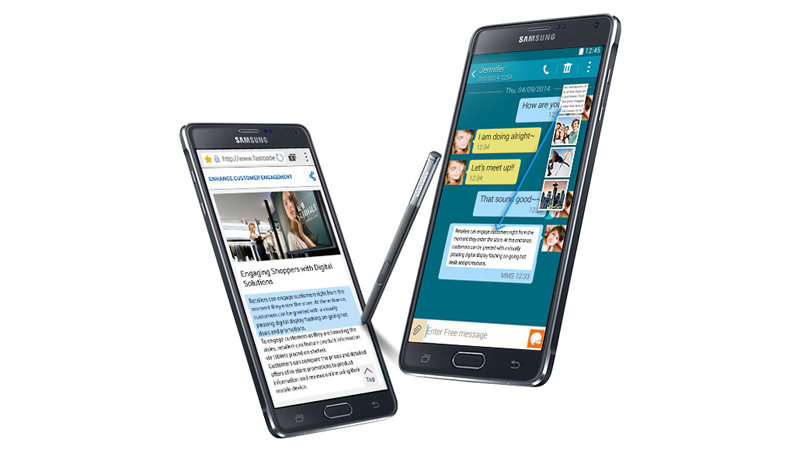This comparison is based on our full reviews of both smartphones, which you can read here:
Google Nexus 6 review Samsung Galaxy Note 4 review
Nexus 6 vs Samsung Galaxy Note 4 comparison: UK price and availability
The Nexus 6 doesn’t follow in the footsteps of previous Nexus smartphones, starting at a shade under £500, which is flagship territory. The Galaxy Note 4 is even more expensive with SIM-free prices starting at £599. That’s Samsung’s recommended price, and it’s tough to find it online much cheaper, even in 2015. Of course, if you’re planning to get one of these phablets on contract, you won’t notice this difference as they can be picked up for around £40 per month. If you are buying a smartphone SIM-free, however, check out the Best SIM-only deals.
Nexus 6 vs Samsung Galaxy Note 4 comparison: Design and build
The Note 4 is similar in design to its predecessor (also see Samsung Galaxy Note 3 vs Samsung Galaxy Note 4), with a faux leather back. It’s smaller than the Nexus 6 in every dimension and is lighter too. Relatively speaking, both are enormous smartphones of course.
Galaxy Note 4: 153.5×78.6×8.5mm, 176gNexus 6: 159.3x83x10.1mm, 184g
The metal-bodied Nexus 6 is very much a super-sized Motorola Moto X, but lacks the fingerprint scanner, UV scanner, heart-rate monitor and S-Pen of the Note 4. Google offers the Nexus 6 in midnight blue or cloud white, while the Note 4 comes in jet black, classic white, blush pink or copper gold.
Nexus 6 vs Samsung Galaxy Note 4 comparison: Display
Both phablets have super-high-resolution Quad HD displays, but the Nexus 6’s is slightly larger at 5.96in against the Samsung’s 5.7in. Given the difference in size the Samsung’s has the higher pixel density (515ppi vs 493ppi), but at this level you really won’t be able to tell – both look amazing.
There are more similarities: both screens are protected by Gorilla Glass 3 and use AMOLED technology. When compared with more common LED backlit IPS screens, AMOLED offers even better viewing angles as well as higher contrast with deeper blacks, but some people don’t like the overly vibrant colours which don’t necessarily make images look natural. Thanks to the fact that Samsung’s SuperAMOLED screen integrates touch sensitivity into the screen rather than adding it as another layer – as the Nexus 6 does – the Note 4’s screen has fewer reflections and seems more immersive. Both are excellent screens, but the Samsung’s is marginally better.
Nexus 6 vs Samsung Galaxy Note 4 comparison: Processor and performance
In the UK the Galaxy Note 4 has a Snapdragon 805 processor which can run at up to 2.7GHz. It also has Adreno 420 graphics and 3GB of RAM. That’s the exact same spec as the Nexus 6, so it’s unsurprising that they matched each other in our benchmarks.
Nexus 6 vs Samsung Galaxy Note 4 comparison: Storage, connectivity and extras
Both phablets also 32GB of storage, but while you can pay £50 extra for a 64GB Nexus 6, the Note 4 has a microSD slot for adding cards up to 128GB. The Nexus 6 has great front-facing stereo speakers, but the Galaxy Note 4 has arguably better extras. For a start, there’s the S-Pen stylus that has long been adored by fans of the Galaxy Note range. It also has an on-demand heart-rate sensor, a fingerprint scanner and UV scanner. The Note 4 is also compatible with the full range of Samsung fitness gadgets and Gear VR, Samsung’s virtual-reality headset. Connectivity wise there’s little difference: both are 4G phones with support for dual-band 802.11ac Wi-Fi, NFC, Bluetooth 4.1 and GPS. Also see: What’s the fastest smartphone?
Nexus 6 vs Samsung Galaxy Note 4 comparison: Cameras
On paper the Note 4’s 16Mp camera beats the Nexus 6’s 13Mp, but the Google phone has a dual-tone flash. Both have optical stabilisation and can record 4K video. If it’s selfies or video chat you’re interested in then the Samsung is the better-specified here, too. Whereas the Nexus 6 has a 2.1Mp front-facing camera, the Note 4 has a 3.7Mp, f/1.9 camera with a Wide Selfie Mode for better groufies. Here’s a shot from the Nexus 6: And here’s the same shot (unfortunately taken on a different day) from the Note 4: This video (1080p) was shot on the Nexus 6:
And this 1080p video was taken using the Note 4:
Nexus 6 vs Samsung Galaxy Note 4 comparison: Battery
Both phablets have 3220mAh batteries that support fast charging. Google says you can get six hours of use from a 15-minute charge on the Nexus 6, while Samsung claims a 50 percent charge is possible in half an hour on the Note 4. (It takes around 45 minutes to reach half capacity from empty with the Nexus 6.) The Nexus 6 also supports Qi wireless charging, which is optional on the Note 4. We found that both devices easily lasted a day with around a third left. However, battery life always depends on your actual usage, so it will vary from 1-2 days.
Nexus 6 vs Samsung Galaxy Note 4 comparison: Software
The Nexus 6 was the first smartphone to run Android Lollipop, while the Samsung Galaxy Note 4 shipped with KitKat – see Android KitKat vs Android Lollipop. An update to Lollipop is imminent for the Note 4. The big difference is that the Nexus 6 has plain Android, whereas Samsung installs its TouchWiz UI and several apps. The most notable one is S Health, which works with the Note 4’s heart-rate monitor. On the Galaxy Note 4 we were pleased to find Samsung has improved Multi Window’s usability, incorporating it into the Recent key. This feature lets you run an app in a pop-out window, while Split View runs two apps side-by-side – useful if, for instance, you’re copying an address from an email into Google Maps. Other changes include dynamic lock screens.
Nexus 6 vs Samsung Galaxy Note 4 comparison: Verdict
We really like the Nexus 6, but the Samsung Galaxy Note 4 beats it in virtually every area. In practice, the Nexus 6 is too big and bulky; the Note 4 is still a big smartphone, but it’s easier to handle for most people. The Nexus 6 has great speakers and unadulterated Android Lollipop going for it. The Note 4 has better advantages for some people, such as the S-Pen and microSD slot. Yes, the Note 4 is a little more expensive, but if you’re getting the phone on contract this will be largely irrelevant. Read next: Google Nexus 6 vs iPhone 6 Plus. Follow Marie Brewis on Twitter. Marie is Editor in Chief of Tech Advisor and Macworld. A Journalism graduate from the London College of Printing, she’s worked in tech media for more than 17 years, managing our English language, French and Spanish consumer editorial teams and leading on content strategy through Foundry’s transition from print, to digital, to online - and beyond.




